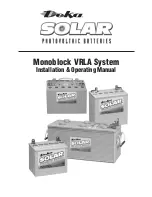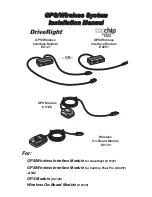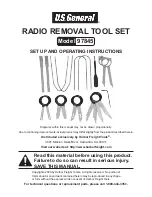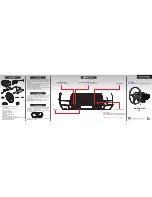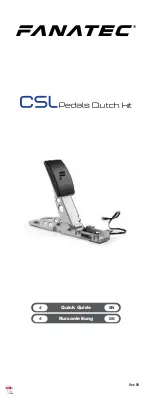
7
State of Charge
Battery state of charge can be determined by measuring the
open circuit voltage. Consult the below table.
State of Charge vs. Open Circuit Voltage*
NOTE: Divide values in half for 6-volt battery(ies)
*The “true” O.C.V. of a battery can only be determined after the
battery has been removed from the load (charge / discharge)
for 24 hours.
RECORD KEEPING
Voltages, Temperatures & Ohmic Readings
Consult User Manual of specific application for additional
Safety & Operating requirements.
Record keeping is an important part of battery mainte-nance
and warranty coverage. This information will help in establish-
ing a life history of the battery and inform the user if and when
corrective action needs to be taken. (Refer to Appendix B,
Battery Maintenance Report).
After installation and the batteries are at a fully charged
condition, the following data should be recorded:
Depending on application, some of the following recommen-
dations may not apply.
• Battery and/or string terminal voltage
• Charger voltage
• Individual battery float / charge voltages
• Individual battery ohmic readings**
• Ambient temperatures
• Terminal connections should be checked to verify all
connections are properly torques. Micro-ohm readings
should be taken across every connection. Refer to meter
manufacturer’s instructions for proper placement of
probes. If any reading differs by more than 20% from its
initial installation value, re-torque the connections. If the
reading still remains high, clean contact surfaces
according to installation portion of this manual.
** Note: To provide accurate consistent values, battery sys-
tems must be fully charged, at same temperature and probes
placed at same location each time readings are taken.
MAINTENANCE
Always wear eye protection when working on or near batteries.
Keep sparks and open flames away from batteries at all times.
Consult User Manual of specific application for additional
Safety & Operating requirements.
Annual Inspection
Depending on the application, some of the following recom-
mendations may not apply.
1. Conduct a visual inspection of the battery(ies).
2. Record battery and /or string voltage. The accuracy of the
DMM (Digital Multimeter) must be 0.05% (on dc scale) or
better. The DMM must be calibrated to NIST traceable
standards. Because voltage readings are affected by dis-
charge and recharges, for cyclic applica¬tions, the
battery(ies) must be in a fully charged condition prior to
taking readings. Batteries should be within ± 0.30 volts (+
0.15 volts for 6V) of the average battery float voltage.
3. Record charger voltage.
4. Record the ambient temperature.
5. Record individual battery ohmic readings.***
6. Record all interunit and terminal connection resistances.
Micro-ohm readings should be taken during this
inspec¬tion. If any reading is greater than 20% from initial
readings, retorque the connection. Recheck the micro-ohm
reading. If the reading remains high, clean contact surface
according to installation portion of this manual.
*** Note: To provide accurate / consistent values, battery(ies)
must be fully charged, at same temperature and probes placed
at same location each time readings are taken.
Rectifier Ripple Voltage
FREQUENCY
Ripple that has a frequency greater than 667Hz (duration less
than 1.5ms) is acceptable, unless it is causing additional battery
heating.
Ripple that has a frequency less than 667Hz (duration greater
than1.5ms), must meet the following voltage specification to
be acceptable.
VOLTAGE
Ripple voltage shall be less than .5% peak to peak of the
manufacturer’s recommended string voltage.
Battery Cleaning
Batteries, cabinets, racks, and modules should be cleaned with
clean water. If neutralizing is required, use a mixture of baking
soda and water. Use clean water to remove baking soda
residue. Never use solvents to clean the battery(ies).
Capacity Testing
Capacity tests should not be run unless the battery’s operation
is questionable. Do not discharge the battery(ies) beyond the
specified final voltage. When discharging at higher rates, extra
connectors may be required to prevent excessive voltage drop.
When performing capacity testing and recording data use
applicable standard and/or User Manual.
Should it be determined any individual battery(ies) or cell(s)
need to be replaced, contact your nearest East Penn agent or
East Penn Mfg. Co.
To determine if a battery can deliver its rated capacity, a test
discharge, or capacity test, can be performed. This test helps
determine the “health” of a battery and whether or not it
should be replaced.
Only experienced battery technicians should be allowed to
prepare a battery for discharge testing and to conduct the
actual discharge test.
% Charge
Gel
AGM
100
12.85 or higher
12.80 or higher
75
12.65
12.60
50
12.35
12.30
25
12.00
12.00
0
11.80
11.80
Содержание SOLAR Monoblock VRLA System
Страница 1: ...Monoblock VRLA System Installation Operating Manual ...
Страница 12: ...10 APPENDIX B Example of typical 3 stage charger ...
Страница 13: ...11 APPENDIX C Depth of Discharge vs Freezing Point ...
Страница 14: ...12 APPENDIX D Capacity vs Operating Temperature ...
Страница 16: ...14 APPENDIX F Charging Current vs Charging Time chart Discharge Voltage Curve ...
Страница 17: ...APPENDIX G ...

